Black Shadows of Saigon

Today we have an interesting tale about a box full of Vincents. It was written by Lee Klancher and first appeared in Tom Cotter’s book, The Vincent in the Barn. We have gained permission to reprint it here for your reading pleasure. If you enjoy the story, be sure to pick up the book. You can also subscribe to our mailing list for a chance to win a free copy. One winner is picked each week. Finally, if you have any of your own barn find stories, please send them in because the best one submitted this year is going to make it into Tom’s next book! Now enjoy the Black Shadows of Saigon…
The city of Saigon houses many secrets. In the early 1950s, the covert dramas playing out in the majestic city’s narrow streets included Corsican drug traffickers stalking American generals, CIA agents covertly supporting the French military who occupied the city, and Viet Minh revolutionaries plotting the downfall of the French.
In a back alley of this giant metropolis now known as Ho Chi Minh City, a crate was abandoned in a warehouse. The crate contained three Vincent motorcycle engines and a pile of other HRD parts that sat forgotten and periodically flooded by murky waters flowing up from the city’s underbelly.
While the engines filled with rotting vegetation, Saigon became a sweltering cauldron of unrest as the largely Buddhist population took increasing offense to the Catholic government.
By 1963, the fighting took to the streets as a coup d’état showered bullets on the walls of the city’s elegant cathedrals, hotels, and theaters. The president was unceremoniously dragged from the palace to be shot, stabbed, and buried in disgrace. Not long after people danced in the streets to celebrate the nation’s new government, those Vincent engines surfaced in a Saigon paper classified ad.
A sharp-eyed Vietnamese man by the name of Nguyen Van Nhon purchased the crate full of Vincent engines and did his best to sell them. He advertised them for sale in the Vincent Owner’s Club magazine, MPH. He claimed to be courting suitors for the engines from Europe, Australia, and New Zealand.
In letters Van Nhon sent to an American pilot, he described the engines in his possession. He expressed calculated passion for the Vincents, but he also understood the value of his find. In fact, this self-labeled “enthusiast” was doing his best to trade the Vincents for stereo equipment, cars, or motorcycles.
“I have purchased the three bikes last year because first I know it must be a very good and fast bike, a famous name,” Van Nhon wrote in a letter dated October 4, 1967. “Secondly it is something like ‘vintage’ and could not get now, especially new condition like this is almost impossible to find. It is the ‘prestige of the past’ that any motorcycle enthusiast like me or like any enthusiast would like to have.”
Van Nhon wrote that he joined the Vincent HRD Owner’s Club in England and was determined to restore at least one of the engines. Perhaps his intentions were authentic, but his actions indicate otherwise.
While corresponding with the pilot, Lieutenant Leon, he expressed his interest in trading the Vincents for Marantz and Fisher stereo components, a 1965 Ford Falcon with a three-speed transmission, or parts for a Harley-Davidson motorcycle. Van Nhon was meticulous with his passions, and his lists of desired equipment were very specific.
Van Nhon noted that one of the engines was in pristine condition, was “brand new from shipment in 1953 or 54,” and the cylinders both had spark holes on the right-hand side. The spark plug holes are a clue for those in-the know in Vincent lore. On a stock Black Shadow, the front cylinder has a spark plug on the right side, while the rear has the plug on the left. The front cylinders flow air better than the rear on Shadow engines, and Lightning motors (as well as all 1955 Series D final production Vincents) use two front cylinders, which means they have both spark plug holes on the right-hand side.
He continued to correspond with the lieutenant, urging him to come to Saigon to see the bikes and trade all or just one of them for his desired equipment.
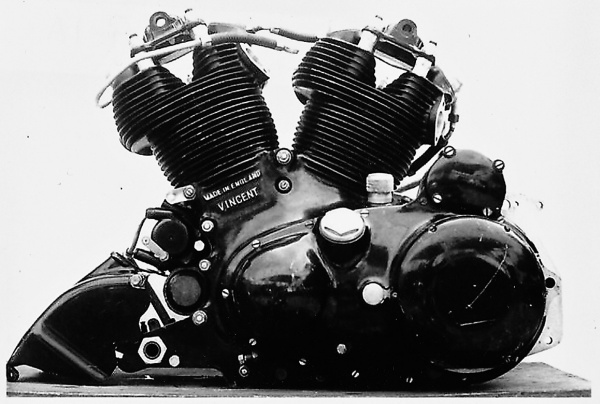
On June 26, 1969, Van Nhon got his wish and sold the “1953 or 54” engine to Bruce Clarke of Florida. The engine was shipped to the United States, but Clarke didn’t keep it for long. He sold the engine to another Florida resident, Rudy Nygrin, on September 2, 1970, for $300 in cash.
When Nygrin took the engine apart, he discovered it was not quite as pristine as promised. The engine had been sitting in the warehouse with the drain plug out, and the interior of the cases had marks from periodic flooding. Rotted bits of plants were inside the cases.
Nygrin took the time and expense to install the engine in a Rapide frame and owned it for quite some time.
The bike’s history had been publicized in MPH in the early 1970s, and readers took a keen interest in how this motorcycle had made its way from Vietnam to the United States. Nygrin saw the articles and letter about his bike and wrote in to describe how he had acquired it. The editor wrote to his readers in one issue, “Many thanks to Rudy for clearing up one of the longest-running Vincent mysteries.”
Motorcycle broker Somer Hooker bought the bike years later and eventually sold it to Wayne Brooks of Huntington Beach, California. The bike changed hands again and ended up being owned by Mark Holmes of Oregon.
Holmes was mostly into cars and didn’t know quite what to do with the bike, so he put it up for sale on eBay in 2005. Texas collector Herb Harris saw the post and noticed that the ad said the bike had a high-performance specification. Like many serious Vincent enthusiasts, he knew about the engine’s Vietnam lineage.
“I bought it because it had history,” Harris said. “With the Black Shadow engine, it might be kind of cool. Almost everyone with a Black Shadow engine has been told it has race history. Only in a very few cases is that actually true.”
Historic or no, the motorcycle was an assembly of randomly acquired parts.
“The bike was a mess,” Harris said. “It was a bitsa—just a piece of this and a piece of that.”
Holmes may not have known what to do with the odd assembly of a Vincent, but he was smart enough to research the bike’s history. While he was purchasing the machine, he had contacted Vince Farell, the registrar for the Vincent club. When Farrell pulled the paperwork on it, he knew the Vietnam Vincent was something special.
“It’s great that this bike has turned up again after all these years; it’s one that’s a bit special,” Farrell wrote. “I have the works records that give all sorts of info on the bikes and where they went in the world. F10AB/1B/9203 was sold as an engine only. It left the Vincent factory in 1952 and was sent to Garreau, who was the French agent in Paris. This agrees with the story of it being found in a box unused in Vietnam.”
The engine specifications were the race pedigree that Holmes referred to in his eBay ad. The bike left the factory equipped with Lightning cams, 32-millimeter carburetors, and 2-inch straight pipes for the exhaust, along with all kinds of hand-fabricated bits.
“Clearly it’s a spare engine for some kind of works bike,” Harris said. He did more research into Vincent history and discovered that the company had sent a large team of riders and bikes to set new world speed records at Montlhéry, France. The engine was built as a works motor and shipped to France just in time for the speed record attempts. “Bam,” Harris said. “There it was.”
Montlhéry 1.5-mile banked concrete oval was a popular place to set speed records, and Vincent was looking to set new records for average speeds over 6, 12, and 24 hours with a Vincent Black Shadow.
They sent a fleet of riders, bikes, and spare engines to France in order to do that. The list of 11 riders included legendary racers John Surtees and Ted Davis. While they had mechanical troubles that ended the bike’s run in the 11th hour, they did set several records. One of them was a six-hour average pace of 100.60 miles per hour, breaking the old record of 96.72 miles per hour.
Vincent’s technical manager, Paul Richardson, wrote at length about his experiences at Montlhéry in his book, Vincent Motor Cycles. In detail one might expect from a professional gearhead and a melodramatic style worthy of a Formula 1 television announcer, he carefully chronicled the historic event.
Richardson notes that French pit workers told the team to use a brush to lube the chain rather than just pouring oil on it, and urged them to use “some oversize flamethrower of French manufacture” rather than stock HRD lighting.
He also discussed the intensity required of the crew in order to keep a motorcycle running for nearly 12 hours. He noted that the support staff, riders, and crew worked tirelessly. He was also pleased to find that the trackside facilities allowed one to relieve oneself and “keep on enjoying the crispness of the Shadow’s exhaust note, lap by lap, even in splendid isolation!”
Despite the fact that the team broke the engine’s crank, they set a number of records that clearly meant a lot to Richardson. “The falling of the first record was a great moment. . . . I had a lump in my throat—tried to congratulate some people—watched the bike on the banking in the brilliant sunshine, sound as a bell.”
He went on to describe how the record attempt left him so spent that he and a “Company Director” fell asleep while attending a strip show at a Paris theater the last night of their trip. He added that some fast talking was required after “short riotous celebrating” took place at the “Horse White” hotel.
“A concerted vocal effort convinced Madame the Proprietress and the one and only Head-Waiter that [we] were jolly good fellows,” Richardson wrote, “and I don’t think we broke anything of value.”
Vincent advertised the bike that set the records as a stock Black Shadow.
The poorly kept truth was the bike was modified nearly to the Lightning’s high-performance specifications and even had hand-fabricated short aluminum manifolds that looked like those used on a Lightning. “They were selling the project as a standard Black Shadow,” Harris said. “It was anything but. . . . It was a racing engine.”
So Herb knew he had purchased a piece of lost history. When he and his guys took the Vietnam Shadow’s engine apart, they found very little wear and tear. “I don’t think the engine ran at Montlhéry,” Harris said. “I think it’s all that’s left of the works record-setting effort.”
One of the other race engines that ran at Montlhéry survived, for a while, but the owner unwittingly stuffed it into a Norton Featherbed frame and eventually parted it out.
Inside the Vietnam Shadow engine’s cases, Harris discovered evidence of the water damage that Nygrin described. The flywheel and cases bore watermarks, which Harris and company faithfully left intact. They also found an abundance of unusual marks on the internals of the engine, which they believe were made by the factory in order to indicate it was a very special engine.
“We started seeing these crazy stamps,” Harris said. “This bike has the only specially numbered set of cranks I have seen.”
Once the surprisingly lightly worn engine was reassembled, Harris had to decide how to restore the bike. He lucked upon an upper frame member that was correct for the bike and started to gather other parts that were as faithful as possible to the original Montlhéry racer.
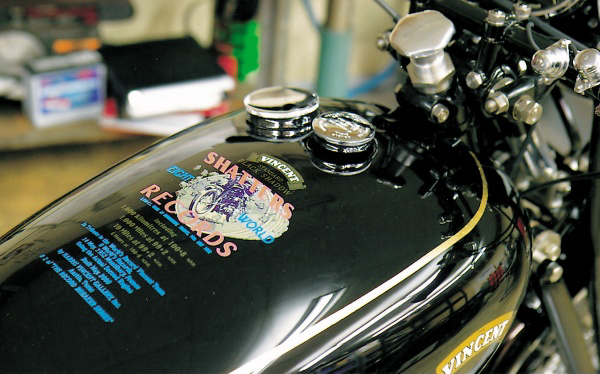
Harris took the opportunity to create a bike that is an interpretation of the original machine. He used a Black Shadow front end and rear frame, a Lightning saddle, and alloy wheels. Black-painted Lightning fenders were mounted, and the gas tank was lightened and dropped down just over an inch to give the bike a low, racy look. A copy of the original Vincent poster announcing the record event has been added to the top of the fuel tank as well.
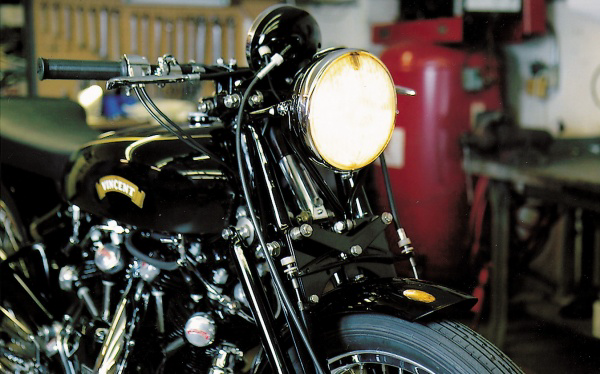
A period-correct French Marchal headlamp with a yellow bulb was fitted, and the speedometer was lowered. The result is a rideable Vincent with a unique history. “It’s loud and fast and should do 100 miles per hour in first gear,” Harris said.
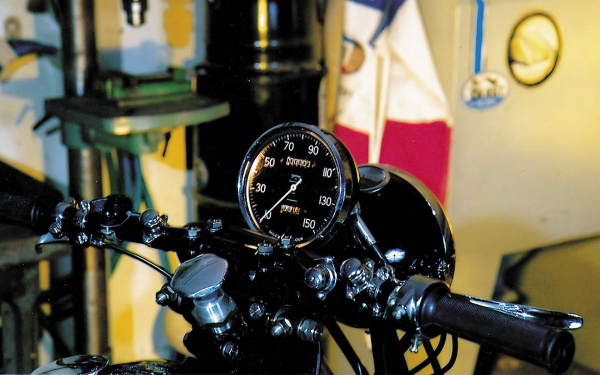
“History in bikes can be lost in one owner,” Harris continued. “My game is to find out what that was. I’m glad I asked the questions. This is one of the most historic bikes I’ve had.”
That’s saying a lot, as Harris’ Vincent collection includes the well-known race bike The Beast and the famous bike Rollie Free set his speed record with in his bathing suit.
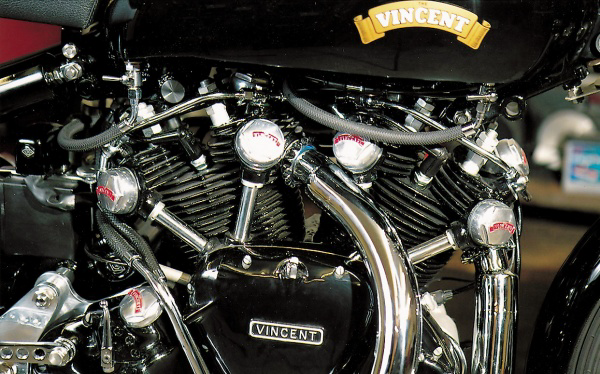
The Vietnam Shadow is more than just a 150-mile-per-hour blast from the past. In fact, the best part of this story has not yet been chronicled. How and why did the engine travel from France to that waterlogged warehouse in Saigon?
The most likely scenario is that a French soldier purchased the engine after the race at Montlhéry and transported it to Saigon. The last of the French soldiers left the country in 1956, and it’s possible that the engines were abandoned when the owner left. Rumor has it that a Thai prince ordered the machines. But that part of this motorcycle’s story is yet to be told.
Another bit of intrigue comes from the letters from Nguyen Van Nhon appealing to Lieutenant Leon to buy the bike. In a long section of one letter, Van Nhon describes each of the three engines and the parts that went along with them in detail. He noted that one of them was a nearly complete motorcycle, which “except for the special tank,” looked quite similar to the famous race bike, Gunga Din .
Gunga Din was brought to Montlhéry in 1952 to set new top speed records. Ted Davis and John Surtees piloted the bike but failed to break any records due to tire failures caused by the unseasonably warm May temperatures. Van Nhon’s note leads one to believe that another race bike with history—perhaps a back-up to Gunga Din ?—made its way to that musty warehouse in Saigon.
The crate certainly contained more than just the Montlhéry engine. Somer Hooker said that it also contained a B Rapide that Van Nhon never completed because the government refused to let him import a 20-inch front tire.
He said the crate also contained a new Black Shadow. That Black Shadow was flown out of the country as Saigon was falling by an Air America pilot and ended up in Australia. He believes the bike was modified and then disappeared. And the Gunga Din motor was a Lightning motor, according to Hooker, “at least in spirit.”
With Van Nhon peddling history for stereos and cars to buyers in Europe, Australia, and New Zealand, Gunga Din’ s close cousin could be moldering away in a musty warehouse nearly anywhere in the world.
The key to finding those Vincents may be found in a newspaper article, letter, or bill of sale tucked into a filing cabinet of Ho Chi Minh City. That story is just another secret held close to the bosom of the steamy city of Saigon.
Auctions Ending Soon
 2006 Ford Mustang Saleen S281 SCBid Now1 days$15,000
2006 Ford Mustang Saleen S281 SCBid Now1 days$15,000
 2002 Subaru Impreza WRXBid Now4 days$100
2002 Subaru Impreza WRXBid Now4 days$100
 1975 Chevrolet Corvette ConvertibleBid Now4 days$3,000
1975 Chevrolet Corvette ConvertibleBid Now4 days$3,000
 1964 Ford F-100 Camper CustomBid Now4 days$500
1964 Ford F-100 Camper CustomBid Now4 days$500
 2006 Jeep Wrangler SportBid Now6 days$4,000
2006 Jeep Wrangler SportBid Now6 days$4,000

Comments
~ as with many great mystery stories this series of events leaves much to the imagination. and as time passes and the presently known facts spread among Vincent lovers perhaps some of the questions will be finally answered.
. i’d like to repeat the invitation to subscribe to the mailing list for a chance to win a free copy of one of Mr. Cotter’s ‘In The Barn’ books. yesterday i returned from the farmers market to find mine waiting. my personal thanks to Tom and Jesse!
i too would like to thank Jesse and Tom. i received ” the Harley in the Barn ” and the book is a great read.
The part about the Vincent being flown out of Vietnam by an Air America pilot reminds me of when McArthur left his men in the Phillipines.He loaded the plane with his furniture,even down to his kid’s tricycle and left (what people have figured) 17-18 people behind for the Bataan Death March.I know some Air America pilots are a different bred and those were different times but every single Vietnamese I saw in the 60s when I was there would have fit times 4 in that space and wouldn’t have been “reeducated”in Vietnam for the next 5-6 years but what is is what is.(if that story is true)
I’m not a motorcycle gearhead but have dealt with Corvettes over the last 44 years and ths engine(taking into account the block numbers)is just like a Corvette number even knowing the factory records.You know the type you have.
To cut to the chase.This is a beautiful bike,the engine is beautiful and I admire anyone that restores things like this down to the beautiful front fork.If you don’t think the fork is as important as the engine,leave it rusty and see what people comment about the most.(They’ll probably say”Did you see that fork?”)
Fantastic research and reading.
These old Vincents are really cool :)
Great read! I always enjoy reading, not only the unusual finds that take place, but the histories that go with them. I’d like to find something like a Vincent hidden in a barn or garage somewhere.
I’ll never forget the time I saw a Vincent Black Shadow blast off into the distance with a swirl of dust billowing up after it. The guy was demonstrating it to a bunch of us teenagers who had never heard of one, let alone ever seen one. I think everyone’s thought at that moment was something like the word “rocketship”, with three !!! points. That was long ago when these were just rare, not rare and valuable.
I was in the US Army over in Germany in 1966-1968. A friend from St. Louis worked in a BSA shop and his boss wrote him, asking him if he wanted to meet him in Birmingham, England to tour the BSA factory. He wrote back asking if he could bring a few friends and I got the opportunity of a lifetime, to go through a motorcycle plant. As we arrived at the plant, one of the workers there had parked his Vincent on the street in front, because it was his daily rider. We checked it out, knowing what it was, the famous and mysterious “Vincent” brand we had been reading about in the motorcycle books of that era. I took pictures of it and still have them “somewhere” in my souvenir stash. I always read anything printed about the Vincents from then on, having seen one in the flesh. Of all the brands in the world, they are probably the most recognized and mysterious name (sorry HD) of a single brand of motorcycle to real enthusiasts, ever. To have seen one in that setting at that time is a much cherished memory for a 66 year old gear head who still rides! Many thanks for the books and Barn Finds articles that refresh memories for all of us. Larry J
I have a 1970’s book on classic bikes and the neatest looking is an Egli-Vincent, an effort to revive the Vincent engine with a new frame built for it. Too few were made, and they weren’t cheap. A big thanks you to Jesse and Tom, my book came and the stories are wonderful, so I’ll be buying the rest of the books.
There is a black 61 Ford Starliner parked behind an old car . Does anyone know about the 61 Srarliner ?